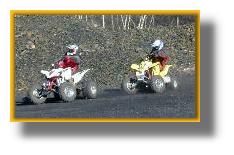2002 Yamaha YFZ450 vs Suzuki Z400 Shootout
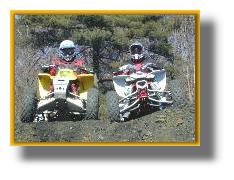 Most readers would expect us to compare two of the most recent releases into the sport market, the Yamaha YFZ 450 and the Honda TRX 450R but we have decided to take a different approach. Let’s give the reader what they really need to know, how would this machine handle against their sport ATV? After all, each time a new machine is released we all secretly ask ourselves how the machine we already own would compare to the newest release ATV. For this test we decide to compare an ATV that has been around for a few years and has proven to be a great performance unit. The Suzuki 400 LTZ, and put it up against the Yamaha YFZ 450. These two Quads have more than their sport segment in common, each of the units had base engines derived from motorcycles. The Suzuki engine is based on the well-proven DR-Z400 Suzuki motorcycle and the Yamaha is a direct descendent of the Yamaha YZ450F dirtbike. Don’t think either one of these manufacturers just slipped a motorcycle engine into a quad frame, both engines had to be calibrated for a larger chassis.
Most readers would expect us to compare two of the most recent releases into the sport market, the Yamaha YFZ 450 and the Honda TRX 450R but we have decided to take a different approach. Let’s give the reader what they really need to know, how would this machine handle against their sport ATV? After all, each time a new machine is released we all secretly ask ourselves how the machine we already own would compare to the newest release ATV. For this test we decide to compare an ATV that has been around for a few years and has proven to be a great performance unit. The Suzuki 400 LTZ, and put it up against the Yamaha YFZ 450. These two Quads have more than their sport segment in common, each of the units had base engines derived from motorcycles. The Suzuki engine is based on the well-proven DR-Z400 Suzuki motorcycle and the Yamaha is a direct descendent of the Yamaha YZ450F dirtbike. Don’t think either one of these manufacturers just slipped a motorcycle engine into a quad frame, both engines had to be calibrated for a larger chassis. The Suzuki engine is a light-weight product composed of an aluminum-alloy, shaving pounds is always an advantage in a race or sport situation. The Z400 cylinder uses Suzuki’s own race-proven nickel-phosphorus-silicon-carbide coating which is otherwise known as SCEM. The powerplant is composed of an oversquare, 90.0×62.6mm, four-stroke, liquid-cooled, DOHC single-cylinder with four valves actuated by cam lobes riding directly on bucket tappets. The cylinder head features a narrow, 28 degree included valve angle for a compact, efficient combustion chamber, with an 11.3:1 compression ratio. This narrowed valve angle allows use of a straighter intake tract between the 36mm Mikuni carburetor and the cylinder head, which in
sport situation. The Z400 cylinder uses Suzuki’s own race-proven nickel-phosphorus-silicon-carbide coating which is otherwise known as SCEM. The powerplant is composed of an oversquare, 90.0×62.6mm, four-stroke, liquid-cooled, DOHC single-cylinder with four valves actuated by cam lobes riding directly on bucket tappets. The cylinder head features a narrow, 28 degree included valve angle for a compact, efficient combustion chamber, with an 11.3:1 compression ratio. This narrowed valve angle allows use of a straighter intake tract between the 36mm Mikuni carburetor and the cylinder head, which in  turn improves charging efficiency. The valves themselves are relatively large, 36mm intakes and 29mm exhausts, all with 5mm stems to improve port flow. The valve springs have aluminum-alloy retainers that are more compact and lighter than conventional valve springs and use steel retainers. The aluminum alloy cylinder reduces weight and improves heat transfer, allowing tighter, more efficient piston-to-cylinder clearance. A counterbalance shaft reduces vibration, while an automatic cam chain tensioner and electric CDI ignition system simplify routine maintenance. Placing the engine lower in the frame because of a slightly angled cylinder head and dry-sump lubrication system makes for a compact design. We loved the surprising amount of powergenerated by the 400 engine, throttle response is very receptive. The QuadSport Z400 features a manual clutch and a five-speed manual transmission with reverse gear. The chassis features a
turn improves charging efficiency. The valves themselves are relatively large, 36mm intakes and 29mm exhausts, all with 5mm stems to improve port flow. The valve springs have aluminum-alloy retainers that are more compact and lighter than conventional valve springs and use steel retainers. The aluminum alloy cylinder reduces weight and improves heat transfer, allowing tighter, more efficient piston-to-cylinder clearance. A counterbalance shaft reduces vibration, while an automatic cam chain tensioner and electric CDI ignition system simplify routine maintenance. Placing the engine lower in the frame because of a slightly angled cylinder head and dry-sump lubrication system makes for a compact design. We loved the surprising amount of powergenerated by the 400 engine, throttle response is very receptive. The QuadSport Z400 features a manual clutch and a five-speed manual transmission with reverse gear. The chassis features a 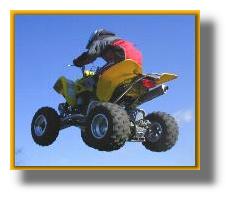 lightweight, rigid, high-tensile steel-alloy tube frame and sub-frame. The suspension is impressive giving the rider confidence when catching air or hopping over fallen logs on the trails. Independent double-wishbone front suspension with preload-adjustable coil-cover shocks delivers 210mm (8.3inches) of wheel travel. The aluminum-alloy swingarm rear suspension system features a single, fully-adjustable piggyback-reservoir shock and produces 231mm (9.1 inches) of wheel travel. The Adjustable Preload feature gives the rider the ability to apply more tension to the spring if the ride feels too soft or less tension if the ride feels stiff. The Adjustable Damping feature lets the rider fine tune the suspension for the surface and/or a better ride. Damping helps regulate the speed that the shock springs compress
lightweight, rigid, high-tensile steel-alloy tube frame and sub-frame. The suspension is impressive giving the rider confidence when catching air or hopping over fallen logs on the trails. Independent double-wishbone front suspension with preload-adjustable coil-cover shocks delivers 210mm (8.3inches) of wheel travel. The aluminum-alloy swingarm rear suspension system features a single, fully-adjustable piggyback-reservoir shock and produces 231mm (9.1 inches) of wheel travel. The Adjustable Preload feature gives the rider the ability to apply more tension to the spring if the ride feels too soft or less tension if the ride feels stiff. The Adjustable Damping feature lets the rider fine tune the suspension for the surface and/or a better ride. Damping helps regulate the speed that the shock springs compress  and extend. When you adjust the compression and rebound damping you are actually adjusting the oil flow through the shock. More compression damping will slow the compression of the shock and more rebound damping will slow the rebound (extension) of the shock. Wheelbase is 1,245mm (49.0 inches) with 262mm (10.3 inches) of ground clearance. The unit weighed in at 380lbs on a digital scale, the dry weight is specked at 370lbs.
and extend. When you adjust the compression and rebound damping you are actually adjusting the oil flow through the shock. More compression damping will slow the compression of the shock and more rebound damping will slow the rebound (extension) of the shock. Wheelbase is 1,245mm (49.0 inches) with 262mm (10.3 inches) of ground clearance. The unit weighed in at 380lbs on a digital scale, the dry weight is specked at 370lbs.
Yamaha YFZ 450
The new Yamaha uses a liquid-cooled, 439cc, 5-valve, DOHC, 4-stroke engine with titanium valves, the combustion is made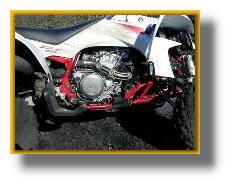 with a 95mm bore and 62mm stroke. This delivers a broad torque curve (for instant hook-up) and high over-rev capacity with crisp, linear throttle response. In other words, the four-stroke engine resembles a two-stroke feel, quick throttle response and a high revving powerband. Largely this is due to a Lightweight crankshaft which keeps inertial mass at a minimum and a Piston which features a short skirt with small pin boss diameter, both help reduce weight and provide faster-revvinglow-rpm response. The engine breaths through a high performance 39mm Keihin FCR flat-slide carburetor with a throttle position sensor which
with a 95mm bore and 62mm stroke. This delivers a broad torque curve (for instant hook-up) and high over-rev capacity with crisp, linear throttle response. In other words, the four-stroke engine resembles a two-stroke feel, quick throttle response and a high revving powerband. Largely this is due to a Lightweight crankshaft which keeps inertial mass at a minimum and a Piston which features a short skirt with small pin boss diameter, both help reduce weight and provide faster-revvinglow-rpm response. The engine breaths through a high performance 39mm Keihin FCR flat-slide carburetor with a throttle position sensor which  delivers ultra-precise fuel/air mixing and again helps with instant throttle response. The fuel/air mix is then fed through Lightweight titanium valves into the combustion chamber, Yamaha even uses load-reduced springs which are super light and help with fast-revving, hard-hitting power delivery across the RPM range. The light weight engine design includes several additional weight-saving engine features such as magnesium cylinder head cover, right side crankcase cover, small-design cam chain tensioner and oil pump, aluminum oil hoseand light CDI ignition unit. There’s no dought about it, the YZF 450 is a race ready ATV, a competition, state-of-the-art high-tensile steel chassis utilizes an advanced suspension for pure performance right off the showroom floor. The front suspension includes independent aluminum upper A-arms front with fully
delivers ultra-precise fuel/air mixing and again helps with instant throttle response. The fuel/air mix is then fed through Lightweight titanium valves into the combustion chamber, Yamaha even uses load-reduced springs which are super light and help with fast-revving, hard-hitting power delivery across the RPM range. The light weight engine design includes several additional weight-saving engine features such as magnesium cylinder head cover, right side crankcase cover, small-design cam chain tensioner and oil pump, aluminum oil hoseand light CDI ignition unit. There’s no dought about it, the YZF 450 is a race ready ATV, a competition, state-of-the-art high-tensile steel chassis utilizes an advanced suspension for pure performance right off the showroom floor. The front suspension includes independent aluminum upper A-arms front with fully adjustable competition-spec Kayaba piggyback shocks supplying 9.1″ of travel and separate adjusters for preload, rebound and compression damping. The rear suspension system is composed of a YZ linkage-type that features a fully adjustable Showa shock with 10.1″ of travel and separate adjusters for preload, rebound and compression damping. The rear swingarm is made from ultra-rigid cast aluminum whichagain reduces weight and ensures an optimal, flex-free suspension. Again, light weight is what this ATV is all about, every step
adjustable competition-spec Kayaba piggyback shocks supplying 9.1″ of travel and separate adjusters for preload, rebound and compression damping. The rear suspension system is composed of a YZ linkage-type that features a fully adjustable Showa shock with 10.1″ of travel and separate adjusters for preload, rebound and compression damping. The rear swingarm is made from ultra-rigid cast aluminum whichagain reduces weight and ensures an optimal, flex-free suspension. Again, light weight is what this ATV is all about, every step  has been taken to reduce weight, aluminum upper A-arms, cast aluminum front wheel hubs, and aluminum wheels keep this unit just under 360lbs wet weight.
has been taken to reduce weight, aluminum upper A-arms, cast aluminum front wheel hubs, and aluminum wheels keep this unit just under 360lbs wet weight.
Let’s Compare
There is no other way to really compare two machines other than to get out and really ride and I mean ride hard. The test began with an uncomplicated drag race, both units were lined up and set off on repeated runs. Realize the Yamaha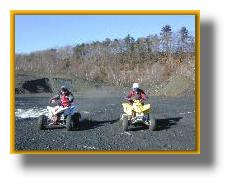 hits hard in the mid to upper power range, this is a high revving engine that uses all the modifications Yamaha could put into a stock ATV, the engine’s personality could be compared to a two-stroke. Each time the Yamaha YFZ 450 would just pull ahead slightly, we found that the Suzuki LTZ 400 has a lower rev limiter that came in at 8,000 RPMs where the Yamaha 450 topped out at 10,000 RPMs. This engine characteristic makes a great difference in flat out racing. Supply the Suzuki 400 with an aftermarket rev box and we feel the Suzuki would be much closer at the finish line.
hits hard in the mid to upper power range, this is a high revving engine that uses all the modifications Yamaha could put into a stock ATV, the engine’s personality could be compared to a two-stroke. Each time the Yamaha YFZ 450 would just pull ahead slightly, we found that the Suzuki LTZ 400 has a lower rev limiter that came in at 8,000 RPMs where the Yamaha 450 topped out at 10,000 RPMs. This engine characteristic makes a great difference in flat out racing. Supply the Suzuki 400 with an aftermarket rev box and we feel the Suzuki would be much closer at the finish line.
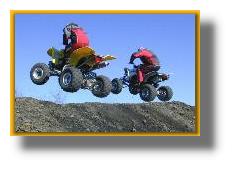 As for handling, again the Yamaha was just slightly better in most aspects, better quality shocks, improved front A-arms and a longer rear swingarm made the difference. Don’t get me wrong, the Suzuki was just as good in most cases. The difference could only be seen by professional racers. Probably the most obvious difference was when jumping, even though our test riders liked the feel of the Suzuki in the air, the Yamaha had produced much better landing the improved suspension was evident. We spent two full days on a test track and wooded trails, the two machines provided stiff competition. There were times when our test riders would play a fierce game of cat and mouse only to never see a real victor. Off cambers and side hill
As for handling, again the Yamaha was just slightly better in most aspects, better quality shocks, improved front A-arms and a longer rear swingarm made the difference. Don’t get me wrong, the Suzuki was just as good in most cases. The difference could only be seen by professional racers. Probably the most obvious difference was when jumping, even though our test riders liked the feel of the Suzuki in the air, the Yamaha had produced much better landing the improved suspension was evident. We spent two full days on a test track and wooded trails, the two machines provided stiff competition. There were times when our test riders would play a fierce game of cat and mouse only to never see a real victor. Off cambers and side hill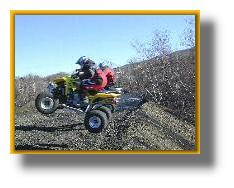 rainbows were Childs play for both machines, racing uphill and downhill again both machines were so close. The Yamaha provides higher gearing. This matched with the high revving power supply produces a great race machine, on the other hand, the Suzuki has a great broad power supply and the overall gearing is slightly lower. Which produces a much better wooded trail machine. The Suzuki’s low-end engine power is just what we like to see in a ‘do everything well’ sport ATV. Bottom line, our test indicated that the Yamaha is a bit faster with acceleration, provides softer landings when jumping and may add a bit more control in high speed turns but two out of three of our test riders indicated that they still preferred the Suzuki for over all ride comfort and feel.
rainbows were Childs play for both machines, racing uphill and downhill again both machines were so close. The Yamaha provides higher gearing. This matched with the high revving power supply produces a great race machine, on the other hand, the Suzuki has a great broad power supply and the overall gearing is slightly lower. Which produces a much better wooded trail machine. The Suzuki’s low-end engine power is just what we like to see in a ‘do everything well’ sport ATV. Bottom line, our test indicated that the Yamaha is a bit faster with acceleration, provides softer landings when jumping and may add a bit more control in high speed turns but two out of three of our test riders indicated that they still preferred the Suzuki for over all ride comfort and feel.

